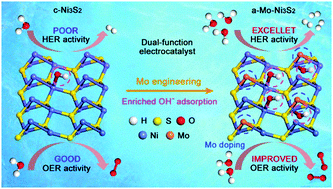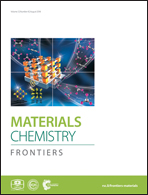Mo-Triggered amorphous Ni3S2 nanosheets as efficient and durable electrocatalysts for water splitting†
Abstract
Exploring efficient non-noble materials as hydrogen evolution reaction (HER) and oxygen evolution reaction (OER) bifunctional electrocatalysts is of great importance for overall water splitting. Herein, we report a low-temperature and rapid synthesis of Mo-triggered amorphous Ni3S2 nanosheets as such dual-function electrocatalysts for the first time by a simple solid-phase melting strategy. It is found that Mo engineering can not only dramatically enhance the adsorption ability of Ni active sites to the active intermediates of HER, but also generate more targeted intermediates for OER. The resulting a-Mo–Ni3S2 catalysts demonstrate exceptionally high HER/OER activity and stability in alkaline media, outperforming the baseline commercial noble-metal (Pt, IrO2 and RuO2) and other reported advanced electrocatalysts to date. A two-electrode electrolyzer assembled using the a-Mo–Ni3S2 electrocatalysts can afford a current density of 1000 mA cm−2 at a voltage of only 1.97 V which is stable for over 300 h. This work provides a feasible tactic to develop efficient and durable bifunctional electrocatalysts by engineering on surfaces and nanostructures.

- This article is part of the themed collection: Materials Chemistry Frontiers HOT articles for 2018


 Please wait while we load your content...
Please wait while we load your content...